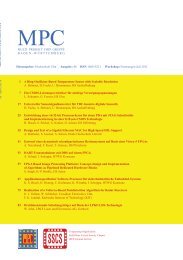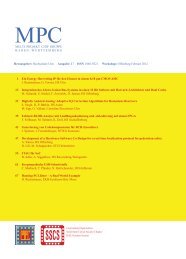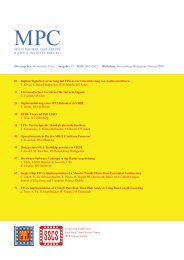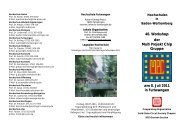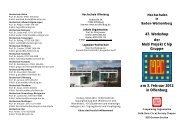Workshopband als PDF - Mpc.belwue.de
Workshopband als PDF - Mpc.belwue.de
Workshopband als PDF - Mpc.belwue.de
Erfolgreiche ePaper selbst erstellen
Machen Sie aus Ihren PDF Publikationen ein blätterbares Flipbook mit unserer einzigartigen Google optimierten e-Paper Software.
MPC-WORKSHOP FEBRUAR 2013<br />
Figure 5: Set-up for Implementation<br />
The dv signal helps the SYN <strong>de</strong>tection block to read<br />
the incoming bits. Due to the start-up <strong>de</strong>lay in the<br />
DPLL the SYN Detection block only takes into account<br />
the last 6 bits of the SYN pattern, that is, if the<br />
string “010100” is <strong>de</strong>tected, a SYNC pattern will be<br />
consi<strong>de</strong>red positive. The SYN <strong>de</strong>tection block <strong>als</strong>o<br />
searches for long strings of ones to <strong>de</strong>tect an idle state.<br />
3) NRZI Decoding and De-Bit Stuffing Block<br />
The NRZI <strong>de</strong>coding block must read a bit when the<br />
dv signal is high to guarantee the correct value has<br />
been stored. Much in the same way, it must <strong>de</strong>liver a<br />
new data valid signal to compensate the <strong>de</strong>lay along<br />
with the <strong>de</strong>co<strong>de</strong>d data. The <strong>de</strong>-bit stuffing block is<br />
<strong>de</strong>signed as a finite state machine with the purpose to<br />
extract the 0 bit whenever 6 consecutive ones are<br />
found. This task is done only by not activating the data<br />
valid signal output whenever the zero should be extracted.<br />
4) CRC Verification Block<br />
The CRC verification block is activated after the<br />
PID field has been read and it is disabled when the<br />
EOP is <strong>de</strong>tected. There are 2 internal verification<br />
blocks, one to check the CRC-5 and the second for<br />
CRC-16, and they both work with the exact logic as<br />
the CRC calculators. They calculate the CRC from the<br />
data being received and compares it to the residual,<br />
mentioned in table 2, to check if there were any errors<br />
in the process.<br />
5) Shift Register and Registers for Saved Data<br />
The shift register is a simple 16 bit register to load<br />
the incoming data before transferring it to the registers<br />
for saved data. It takes the data coming from the <strong>de</strong>-<br />
bit stuffing block when the valid signal is high and<br />
saves it. The 16 bits of the shift register are loa<strong>de</strong>d<br />
into a word of the registers for saved data structure<br />
when the control state machine gives the write signal<br />
in the address provi<strong>de</strong>d.<br />
If the microcontroller wishes to read the information<br />
stored, it uses the input sel of the receiving block; the<br />
four msb chooses the word that will appear in the<br />
parallel output Q; the four lsb runs each of the<br />
bits into the serial output Q. After the receiving<br />
process is over, the control state machine writes the<br />
number of words received into the last register, that<br />
way when the data wants to be read out, the first step<br />
is to read address 1111B for the number of bytes to be<br />
read out.<br />
6) Control State Machine for Reception<br />
The Control State Machine takes care of every control<br />
line in whole receiving structure. The Receptor<br />
Structure offers the possibility to start saving in a<br />
specific register, this is indicated by the adr and mo<strong>de</strong><br />
inputs. If mo<strong>de</strong> is one the control state machine loads<br />
the address from adr to start saving, otherwise it will<br />
start in address zero. If run is activated and either an<br />
EOP or a line of ones (idle state) is <strong>de</strong>tected the waiting<br />
to <strong>de</strong>tect a valid SYN pattern begins. Once this<br />
happens the enable signal for the <strong>de</strong>- bit stuffing is<br />
activated and the process of reception starts.<br />
When the EOP is <strong>de</strong>tected, the control state machine<br />
saves the last data into a register along with the number<br />
of words received and the CRC Verification is<br />
checked. If the data received was only the PID plus 16<br />
bits the CRC5 is taken into account, if there were<br />
more bytes received then the CRC16 is checked.<br />
The outputs of the block are flags; if there is new<br />
data stored the dv_st flag is set, if the correct CRC<br />
was a match the CRC_ok flag is set. The ovrun flag is<br />
set when the last possible register is written to and<br />
there is no more place to save data. The flags are<br />
maintained until the run signal is turned off; once the<br />
run signal is off the flags are reset and the CRCs<br />
cleared.<br />
55



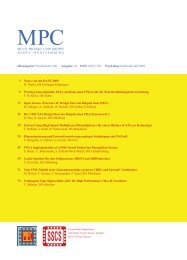
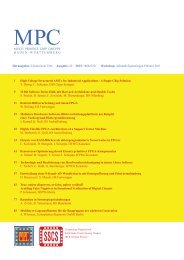
![[Geben Sie hier die Überschrift ein] - MPC](https://img.yumpu.com/8654082/1/188x260/geben-sie-hier-die-uberschrift-ein-mpc.jpg?quality=85)
